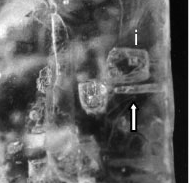What'sNEW Archives, September-October 2000
October 30: Panspermia is reconsidered on Space.com, after the revival of 250-million-year-old halophiles and the news that germs could have survived a trip from Mars. Chandra Wickramasinghe, geophysicist Jay Melosh, British meteoritic researcher Matthew Genge, and writer Paul Davies were interviewed for the stories.
(space.com inks have expired.)

 The New Case for Panspermia, by Robert Roy Britt, Space.com, 30 October 2000. The New Case for Panspermia, by Robert Roy Britt, Space.com, 30 October 2000.
 Panspermia Q and A [with] Chandra Wickramasinghe, by Robert Roy Britt, Space.com, 27 October 2000. Panspermia Q and A [with] Chandra Wickramasinghe, by Robert Roy Britt, Space.com, 27 October 2000.
 ...Panspermia Q and A With Jay Melosh, by Robert Roy Britt, Space.com, 27 October 2000. ...Panspermia Q and A With Jay Melosh, by Robert Roy Britt, Space.com, 27 October 2000.
 Life On Earth Could Have Come From A Mars Rock, by Robert Roy Britt, Space.com, 26 October 2000. Life On Earth Could Have Come From A Mars Rock, by Robert Roy Britt, Space.com, 26 October 2000.
 Introduction... is a related CA webpage. Introduction... is a related CA webpage.
October 27: NASA announces new Mars program. Instead of two missions per launch window there will be one. The six missions planned for this decade include mapping, surface rovers, and collaboration with Italian or French partners. Sample return is postponed from 2005 until at least 2011. "We will seek before we sample," said Scott Hubbard, NASA's Mars Program director.
 NASA Outlines Mars Exploration Program for Next Two decades, NASA, 26 October 2000. NASA Outlines Mars Exploration Program for Next Two decades, NASA, 26 October 2000.
 NASA Unveils Its 21st Century Mars Campaigns, Space.com, 26 October 2000. NASA Unveils Its 21st Century Mars Campaigns, Space.com, 26 October 2000.
 Mars Reality Check: The High Cost, and Hopes, of Exploration, Space.com, 25 October 2000. Mars Reality Check: The High Cost, and Hopes, of Exploration, Space.com, 25 October 2000.
 Life on Mars! is the related CA webpage. Life on Mars! is the related CA webpage.
October 27: Mars meteorite could have brought life. A new analysis shows that the interior of ALH84001 was never too hot for cells to survive. A preliminary report of this result was given at NASA's Astrobiology Conference in April.
 Benjamin P. Weiss et al., "A Low Temperature Transfer of ALH84001 from Mars to Earth" [abstract], p 791-795 v 290 Science, 27 October 2000. Benjamin P. Weiss et al., "A Low Temperature Transfer of ALH84001 from Mars to Earth" [abstract], p 791-795 v 290 Science, 27 October 2000.
 Benjamin P. Weiss and Joseph L. Kirschvink, "Life From Space?" p 8-11, The Planetary Report, November/December 2000. Benjamin P. Weiss and Joseph L. Kirschvink, "Life From Space?" p 8-11, The Planetary Report, November/December 2000.
 Reuters, "Mars Rock Could Have Carried Life, Study Shows," [text], The New York Times, 27 October 2000. Reuters, "Mars Rock Could Have Carried Life, Study Shows," [text], The New York Times, 27 October 2000.
 Meteorites may have transferred life between planets in the solar system, McGill University, 26 October 2000. Meteorites may have transferred life between planets in the solar system, McGill University, 26 October 2000.
 New look at Martian meteorite breathes new life into 'panspermia' theory, exn.ca, 27 October 2000. New look at Martian meteorite breathes new life into 'panspermia' theory, exn.ca, 27 October 2000.
 Astrobiology Conference, 6 April 2000, is the CA What'sNEW item mentioning the preliminary report. Astrobiology Conference, 6 April 2000, is the CA What'sNEW item mentioning the preliminary report.
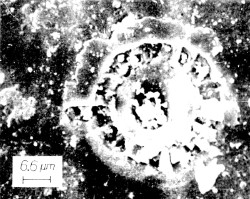
Microfossil from the moon |
October 27: Microorganisms from the Moon — Russian biologists examining published microphotos of lunar regolith examples have noticed that some of the particles are fossilized microorganisms. Stanislav Zhmur and Lyudmila Gerasimenko made the discovery when they took a careful new look at moon material collected in the 1970s by missions of the Soviet Union's unmanned Luna program. Their analysis was first published in December 1999, in the proceedings of an astrobiology conference.
At the same conference, these biologists reported fossilized microorganisms in carbonaceous meteorites, and on 27 January, we publicized that finding. Today, no one doubts that the meteoritic fossils are biological. But it turns out that meteorites can easily become contaminated after contact with the ground, so mainstream science now suspects that all meteoritic fossils are contaminants. The fossilized microorganisms from the moon, however, were delivered to Earth in sealed containers that were opened only in laboratories. They can hardly be the remains of recent, earthly contaminants.
One circular fossil collected by Luna 16 (shown) bears a resemblance to modern spiral filamentous microorganisms like Phormidium frigidum. Other particles returned by Luna 20 plainly resemble fossils of modern coccoidal species like Siderococcus or Sulfolobus. These fossils are tangible evidence for ancient life beyond planet Earth.
 Stanislav I. Zhmur and Lyudmila M. Gerasimenko. "Biomorphic forms in carbonaceous meteorite Alliende and possible ecological system - producer of organic matter hondrites" in Instruments, Methods and Missions for Astrobiology II, Richard B. Hoover, Editor, Proceedings of SPIE Vol. 3755 p. 48-58 (1999). Stanislav I. Zhmur and Lyudmila M. Gerasimenko. "Biomorphic forms in carbonaceous meteorite Alliende and possible ecological system - producer of organic matter hondrites" in Instruments, Methods and Missions for Astrobiology II, Richard B. Hoover, Editor, Proceedings of SPIE Vol. 3755 p. 48-58 (1999).
 Microorganisms from the Moon has the full CA story with additional photos. Microorganisms from the Moon has the full CA story with additional photos.
 9 July 2004: This may be an impact crater after all! See linked images 9 July 2004: This may be an impact crater after all! See linked images  . .
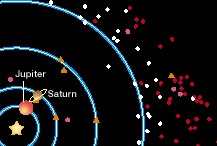 October 25:
October 25: Red and grey Kuiper-belt objects have different orbits. Of the thirteen 'classical' KBOs roughly 45 AU from the sun, the ten very red ones are in orbits close to the the ecliptic plane, while all three grey ones are in tilted orbits. The discovery was made by same astronomers who reported the sharp red - grey color distinction of KBOs in March 1998. At that time, Wickramasinghe and Hoyle speculated that red objects might host microbial activity while grey ones didn't. Because orbits can influence climates, now we are even more intrigued.
 S.C. Tegler and W. Romanishin, "Extremely red Kuiper-belt objects in near-circular orbits beyond 40 AU" [text], p 979 - 981, v 407, Nature, 26 October 2000. S.C. Tegler and W. Romanishin, "Extremely red Kuiper-belt objects in near-circular orbits beyond 40 AU" [text], p 979 - 981, v 407, Nature, 26 October 2000.
 Brian G. Marsden, "Astronomy: The red ragged edge" [text], p 952 - 955, v 407, Nature, 26 October 2000. Brian G. Marsden, "Astronomy: The red ragged edge" [text], p 952 - 955, v 407, Nature, 26 October 2000.
 Rash of Red Asteroids Puzzles Researchers, by Robert Roy Britt, Space.com, 25 October 2000. Rash of Red Asteroids Puzzles Researchers, by Robert Roy Britt, Space.com, 25 October 2000.
 ...Two distinct classes of Kuiper-belt objects..., 21 March 1998, is the related CA What'sNEW item. ...Two distinct classes of Kuiper-belt objects..., 21 March 1998, is the related CA What'sNEW item.
 The Astonishing Redness of Kuiper-belt Objects is Wickramasinghe and Hoyle's story. The Astonishing Redness of Kuiper-belt Objects is Wickramasinghe and Hoyle's story.
October 23: An astrobiologist's recommendations for Mars — Chris McKay of NASA's Ames Research Center thinks we should bio-engineer Mars with life from Earth, unless Mars has life already. In that case, we should enable that life to flourish there separately. McKay's discussion of the possible similarity of newfound life forms to ours — only biochemically, or also genetically — is especially illuminating. Cosmic Ancestry expects any life on Mars to resemble Earth's in both ways.
 Balancing The Rights Of Indigenous Martian Life Over Human Exploration, by Christopher P. McKay, SpaceDaily.com, 23 October 2000. Balancing The Rights Of Indigenous Martian Life Over Human Exploration, by Christopher P. McKay, SpaceDaily.com, 23 October 2000.
 Life on Mars! is a related CA webpage. Life on Mars! is a related CA webpage.
Detail of salt crystal showing the brine inclusion that contained the bacterium (below "i"). The inclusion is approximately 3x3x1 mm. A drill hole is visible above the vertical arrow. |
October 19, 2000: 250 Million-year-old bacteria have been revived. Previously unknown spore-forming bacteria were isolated from a brine inclusion within a salt crystal collected in October 1998, at a depth of 569 meters in a mineshaft in Carlsbad, New Mexico. The analysis by two biologists and a geologist was done so carefully at every stage that contamination is extremely unlikely.
Even more ancient claims exist, but the care taken in this investigation extends the proven survival time of bacterial spores, established by Cano and Borucki in 1995, from tens to hundreds of millions of years. In commentary on the report R. John Parkes wonders, "If bacteria can survive for this length of time, why should they die at all?" And The Washington Post says, "If the findings are upheld, [they] will strengthen arguments that seeds of life might have spread to Earth (or vice versa)...."
The ancient age of the salt crystals from the Permian Salado Formation is confirmed by fossils in overlying strata and by the radiometric ages of minerals above and around the extraction. Crystal features and original structures in the Salado beds indicate that the salt particles were not disturbed after they formed. Most, but not all scientists, find the report convincing. (For a doubter, see Nicholas Wade.)
 Russell H. Vreeland, William D. Rosenzweig and Dennis W. Powers, "Isolation of a 250 million-year-old halotolerant bacterium from a primary salt crystal" [abstract], p 897-900, v 407, Nature, 19 October 2000. Russell H. Vreeland, William D. Rosenzweig and Dennis W. Powers, "Isolation of a 250 million-year-old halotolerant bacterium from a primary salt crystal" [abstract], p 897-900, v 407, Nature, 19 October 2000.
 R. John Parkes, "Microbiology: A case of bacterial immortality?" p 844-845, v 407, Nature, 19 October 2000. R. John Parkes, "Microbiology: A case of bacterial immortality?" p 844-845, v 407, Nature, 19 October 2000.
 Kathy Sawyer, "Oldest Living Bacteria Are Revived" [text], p A02, The Washington Post, 19 October 2000. Kathy Sawyer, "Oldest Living Bacteria Are Revived" [text], p A02, The Washington Post, 19 October 2000.
 Nicholas Wade, "Ancient Bacterium Is Reported Found" [text], The New York Times, 19 October 2000. Nicholas Wade, "Ancient Bacterium Is Reported Found" [text], The New York Times, 19 October 2000.
 Hardcore hibernation, by David Adam, Nature science update, 19 October 2000. Hardcore hibernation, by David Adam, Nature science update, 19 October 2000.
 Scientists revive 250 million-year-old bacteria, by Matthew Fordahl, AP, Nandotimes.com, 18 October 2000. Scientists revive 250 million-year-old bacteria, by Matthew Fordahl, AP, Nandotimes.com, 18 October 2000.
 Alive...after 250 million years, BBCNews, 18 October 2000. Alive...after 250 million years, BBCNews, 18 October 2000.
 Bacteria... is a related CA webpage referencing Cano and Borucki. Bacteria... is a related CA webpage referencing Cano and Borucki.
 Can The Theory Be Tested? is a related CA webpage. Can The Theory Be Tested? is a related CA webpage.
 Cindy L. Satterfield et al, "New evidence for 250 Ma age of halotolerant bacterium from a Permian salt crystal" [abstract], doi:10.1130/G21106.1, p 265-268 v 33 n 4, Geology, Apr 2005: "These results support the 250 Ma age of the fluid inclusions, and by inference, the long-term survivability of microorganisms such as Virgibacillus sp." Cindy L. Satterfield et al, "New evidence for 250 Ma age of halotolerant bacterium from a Permian salt crystal" [abstract], doi:10.1130/G21106.1, p 265-268 v 33 n 4, Geology, Apr 2005: "These results support the 250 Ma age of the fluid inclusions, and by inference, the long-term survivability of microorganisms such as Virgibacillus sp."
 October 15:
October 15: Entire genetic regions appear to have been transferred between species. Many have been transferred between domains, from bacteria to archaea. This conclusion comes from the international team that recently sequenced the genome of the archaebacterium Thermoplasma acidophilum. The conserved clusters, averaging about three genes in size, tend to be found near "hot spots" on the chromosome. In commentary to the article in Nature, Don Cowan calls the high level of transferred genes "the most startling observation" to come from the new sequence.
 Andreas Ruepp et al., "The genome sequence of the thermoacidophilic scavenger Thermoplasma acidophilum" [abstract], p 508-513, v 407, Nature, 28 September 2000. Andreas Ruepp et al., "The genome sequence of the thermoacidophilic scavenger Thermoplasma acidophilum" [abstract], p 508-513, v 407, Nature, 28 September 2000.
 Don Cowan, "Use your neighbour's genes" [text], p 466-467, v 407, Nature, 28 September 2000. Don Cowan, "Use your neighbour's genes" [text], p 466-467, v 407, Nature, 28 September 2000.
 Viruses... is a related CA webpage. [Next-What'sNEW about HGT-Prev] Viruses... is a related CA webpage. [Next-What'sNEW about HGT-Prev]
 October 13:
October 13: More about Tagish Lake meteorite. A story in today's Science gives preatmospheric orbit, mass, and initial compositional characterization of the meteorite that fell in Canada's Yukon territory on 18 January. Probably from the Apollo asteroids, it struck the atmosphere with a mass estimated at 200,000 kilograms. Its primitive material adds much to our knowledge of the early solar system. We await a search for fossilized germs in it.
 Peter G. Brown et al., "The Fall, Recovery, Orbit, and Composition of the Tagish Lake Meteorite: A New Type of Carbonaceous Chondrite" [abstract], p 320-325, v 290, Science, 13 October 2000. Peter G. Brown et al., "The Fall, Recovery, Orbit, and Composition of the Tagish Lake Meteorite: A New Type of Carbonaceous Chondrite" [abstract], p 320-325, v 290, Science, 13 October 2000.
 Jeffrey N. Grossman, "A Meteorite Falls on Ice" [summary], p 283-285, v 290, Science, 13 October 2000. Jeffrey N. Grossman, "A Meteorite Falls on Ice" [summary], p 283-285, v 290, Science, 13 October 2000.
 John Noble Wilford, "Clues to Life May Come From Meteorite" [text], The New York Times, 13 October 2000. John Noble Wilford, "Clues to Life May Come From Meteorite" [text], The New York Times, 13 October 2000.
 Cosmic Time Capsule: Frozen Yukon Meteorite Found, by Robert Roy Britt, Space.com, 12 October 2000. Cosmic Time Capsule: Frozen Yukon Meteorite Found, by Robert Roy Britt, Space.com, 12 October 2000.
 Is Meteorite Most Primitive Sample Of Solar System?, by Steven N. Koppes, Unisci.com, 13 October 2000. Is Meteorite Most Primitive Sample Of Solar System?, by Steven N. Koppes, Unisci.com, 13 October 2000.
 Meteorites may be most primitive solar system material ever studied, University of Calgary, 12 October 2000. Meteorites may be most primitive solar system material ever studied, University of Calgary, 12 October 2000.
 Comets... is a related CA webpage. Comets... is a related CA webpage.
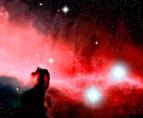 October 6:
October 6: Isolated giant planets forming. Researchers from the Instituto de Astrofisica de Canarias (IAC), the California Institute of Technology and the Max Planck Institut für Astronomie, have discovered in the Orion region three giant planets and fifteen other bodies that resemble planets. The bodies are between 5 and 15 times the mass of Jupiter and are not associated with any star. Rather, they roam freely in Orion's Sigma cluster approximately 1000 light years from Earth. They are estimated to be one to five million years old. Spectra of three of the objects from the Keck telescopes in Hawaii revealed temperatures of 1700 to 2200 kelvin. After they cool sufficiently, might such bodies provide refuge for life, as Caltech's David J. Stevenson suggested in 1999?
 M. R. Zapatero et al., "Discovery of Young, Isolated Planetary Mass Objects in the [Sigma] Orionis Star Cluster" [abstract], p 103-107, v 290, Science, 6 October 2000. M. R. Zapatero et al., "Discovery of Young, Isolated Planetary Mass Objects in the [Sigma] Orionis Star Cluster" [abstract], p 103-107, v 290, Science, 6 October 2000.
 Robert Irion, "Giant 'Planets' on the Loose in Orion?" [summary], p 26, v 290, Science, 6 October 2000. Robert Irion, "Giant 'Planets' on the Loose in Orion?" [summary], p 26, v 290, Science, 6 October 2000.
 John Noble Wilford, "Unidentified Floating Objects: Not Quite Stars or Planets" [text], The New York Times, 10 October 2000. John Noble Wilford, "Unidentified Floating Objects: Not Quite Stars or Planets" [text], The New York Times, 10 October 2000.
 Birth of Lonely Giant Planets Observed, IAC, 5 October 2000. Birth of Lonely Giant Planets Observed, IAC, 5 October 2000.
 When is a Planet Really a Planet?, Astronomy.com, n.d. When is a Planet Really a Planet?, Astronomy.com, n.d.
 Life-sustaining planets in interstellar space? is the What'sNEW item re Stevenson, 1 July 2000. Life-sustaining planets in interstellar space? is the What'sNEW item re Stevenson, 1 July 2000.
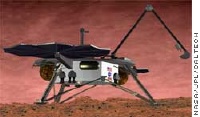 mothballed Mars Lander
mothballed Mars Lander |
October 2: NASA's new Mars plan to be announced this month. The mission to return a sample from Mars could be accomplished in a variety of ways. All are under consideration after the Mars Orbiter and Mars Polar Lander missions failed in 1999. For example, Houston suggests that samples could be returned to the Space Shuttle instead of directly back to Earth's surface. The likely delay that such a change would cause is disappointing to some at Ames, like Chris McKay. One possibility, to launch the completed but mothballed Mars Surveyor 2001 Lander, is being promoted by a Connecticut aerospace engineer.
 Mars Sample Return: Here's the Scoop, by Leonard David, Space.com, 2 October 2000. Mars Sample Return: Here's the Scoop, by Leonard David, Space.com, 2 October 2000.
 Homegrown Movement to Save Scrapped Probe, by Andrew Bridges, Space.com, 2 October 2000. Homegrown Movement to Save Scrapped Probe, by Andrew Bridges, Space.com, 2 October 2000.
 Life on Mars! is the related CA webpage. Life on Mars! is the related CA webpage.
 varying yeast forms grown in prion experiment varying yeast forms grown in prion experiment |
September 27, 2000: Prions can turn on genetic programs. Two geneticists from The University of Chicago and the Howard Hughes Medical Institute have found that a prion can cause a yeast cell's translation mechanism to "read through" a stop codon and translate a previously silent genetic sequence. The researchers see the phenomenon as a needed way for duplicated genes to acquire new functions and drive evolution as Susumu Ohno suggested in 1970. They write that before this discovery, "the known mechanisms for the reactivation of inactive genes work sporadically, act infrequently and provide no obvious means for sampling coding changes in several genes simultaneously." Prions are misfolded proteins that can cause diseases like mad-cow disease, scrapie in sheep, and Creutzfeldt-Jakob disease in humans. It came as a surprise in the 1990s that a protein — with no genetic material — can cause a communicable disease. But enzymatic proteins can initiate cascades of genetic activity; and the possibility for misfolded proteins with altered enzymatic activity to act as infectious agents has recently become accepted. Now, we welcome the new discovery that the promotion of "read-through" by prions may serve an evolutionary purpose. Thus prions align with the better-known infectious agents, viruses and bacteria, that have already begun to be recognized as having major roles in evolution.
 Lindquist
Lindquist |
We wish, however, that such discoveries were not over-hyped as in the EurekAlert announcement of this one: "Prions... may hold the key to a major mystery in evolution: how survival skills that require multiple genetic changes arise all at once when each genetic change by itself would be unsuccessful and even harmful." Prions may well provide another way to switch on previously silent genetic sequences, in addition to that provided by mechanisms like nonsense mutations in supressor genes. But the prion research does not show how a lengthy strand of nucleotides acquires a precise rearrangement with the specific new meaning that is necessary for macroevolutionary progress. Unfortunately, Darwinian theory is still stumped by that problem. Mutation is fine for variation, or microevolution, as seen in the different yeast forms and very many other examples. But for macroevolutionary progress, under Darwinian theory, the monkeys still have to write Shakespeare.We note another thing. Even if this discovery did achieve the solution attested, it would not advance Darwinian theory. Rather, it's one step backward, one step forward. "A major mystery in evolution" — that Darwinians have heretofore alleged to be no mystery at all — is finally acknowledged and claimed to be solved, all at once. Yet such hype reinforces the common impression that new research continues to strengthen the Darwinian account of macroevolutionary progress. The research is good; the hype is bad.
 Heather L. True and Susan L. Lindquist, "A yeast prion provides a mechanism for genetic variation and phenotypic diversity" [abstract], p 477-483, v 407, Nature, 28 September 2000. Heather L. True and Susan L. Lindquist, "A yeast prion provides a mechanism for genetic variation and phenotypic diversity" [abstract], p 477-483, v 407, Nature, 28 September 2000.
 Prions may play crucial role in evolution, University of Chicago Medical Center, 27 September 2000. Prions may play crucial role in evolution, University of Chicago Medical Center, 27 September 2000.
 Yeast Prions Spur Generation of New Traits, Howard Hughes Medical Institute, 28 September 2000. Yeast Prions Spur Generation of New Traits, Howard Hughes Medical Institute, 28 September 2000.
 Viruses... is a related CA webpage. [Next-What'sNEW about HGT-Prev] Viruses... is a related CA webpage. [Next-What'sNEW about HGT-Prev]
 Neo-Darwinism: The Current Paradigm is a related CA webpage. Neo-Darwinism: The Current Paradigm is a related CA webpage.
 A prompted reply from Susan Lindquist elaborates on the mechanism. A prompted reply from Susan Lindquist elaborates on the mechanism.
 September 26:
September 26: Organic Pigments on Mars? This is the preliminary claim of Serguei M. Pershin, a spectroscopist with the Department of Cosmogeophysics at the Russian Space Research Institute in Moscow. He analyzed Hubble Space Telescope images using a two-band radiance-ratio technique to detect evidence of pigments possibly derived from cyanobacteria-like organisms in sediments in the western Utopia Planitia region of Mars. If the pigments are biological, they could be ancient or recent.
 [PDF] "Organic Pigments on Mars Surface?" by Serguei M. Pershin, presented at The 32nd Vernadsky/Brown Microsymposium on Comparative Planetology, Moscow Russia, 9-11 October 2000. [PDF] "Organic Pigments on Mars Surface?" by Serguei M. Pershin, presented at The 32nd Vernadsky/Brown Microsymposium on Comparative Planetology, Moscow Russia, 9-11 October 2000.
 Russian Scientist Finds Organic Pigments on Mars, Barry E. DiGregorio, SpaceDaily.com, 26 September 2000. Russian Scientist Finds Organic Pigments on Mars, Barry E. DiGregorio, SpaceDaily.com, 26 September 2000.
 Life on Mars! is the related CA webpage. Life on Mars! is the related CA webpage.
September 25: "...Possible Seeds for Life on Earth." An article about large organic molecules detected by the mass spectrometer on Stardust is available in English on this website. The particles contain not the expected minerals, but the elements of life. "After having excluded the dominance of several elements, we were left with only 5 elements which could have built up the majority of these polymers, namely: Hydrogen (H), carbon (C), nitrogen (N), oxygen (O), and (unsure) sulfur (S)." The large particles resemble "tars" that, if found on earth, would be considered biological products. The original article was published in German in May 2000, after the finding was announced on 26 April.
 The Physical and Chemical Properties of Interstellar Dust and Dust in Comets: Possible Seeds for Life on Earth is the English translation. The Physical and Chemical Properties of Interstellar Dust and Dust in Comets: Possible Seeds for Life on Earth is the English translation.
 Most interstellar particles captured by Stardust are complex organic compounds is CA's What'sNEW item of 27 April reporting the finding. Most interstellar particles captured by Stardust are complex organic compounds is CA's What'sNEW item of 27 April reporting the finding.
 Franz R. Krueger and Jochen Kissel, "First Direct Chemical Analysis of Interstellar Dust", p 326-329, v 39, Sterne und Weltraum, May 2000 [the original article]. Franz R. Krueger and Jochen Kissel, "First Direct Chemical Analysis of Interstellar Dust", p 326-329, v 39, Sterne und Weltraum, May 2000 [the original article].
September 20: Mars appears to have a huge underground ice reservoir. Culling through photos of Mars' surface taken in the 1970s by Viking Orbiters, University of Central Florida astronomer Nadine Barlow and her assistant, John Koroshetz, studied the morphology of craters and their ejecta. The patterns are consistent, Barlow said, with varying amounts of subsurface water, both in liquid and ice form. A giant underground pocket of ice might start just 650 feet or less below the surface of the Solis Planum region. [Thanks, Larry Klaes.]
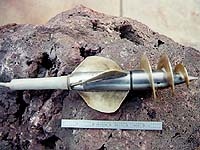 early design for Mars drill
early design for Mars drill |
 Mars Researchers Spot Big Ice Deposit, by Leonard David, Space.com, 20 September 2000. Mars Researchers Spot Big Ice Deposit, by Leonard David, Space.com, 20 September 2000.
September 20: A robotic mole that can drill deep into Mars and return samples to the surface through a tube is being developed by a team at NASA's Jet Propulsion Laboratory in Pasadena, California. This group expects any water to be found thousands of meters below the surface.
 Digging For Life On Mars, by Mark Schrope, SpaceDaily.com, 12 September 2000. Digging For Life On Mars, by Mark Schrope, SpaceDaily.com, 12 September 2000.
 A Plan to Drill Mars, by Mark Schrope, SpaceDaily.com, 26 September 2000. A Plan to Drill Mars, by Mark Schrope, SpaceDaily.com, 26 September 2000.
 Life on Mars! is a related CA webpage. Life on Mars! is a related CA webpage.
September 20: Stardust, by John Gribbin — For anyone curious about the sources for the chemical elements of life, this new book has the story. From the manufacture of hydrogen and helium in the big bang, to nucleosynthesis inside stars, to the production of the heaviest elements in supernovae, John Gribbin explains these phenomena in terms any interested person can understand. Often he stands slightly back from the day-to-day story, giving a full panorama that is usually seen only in textbooks. But textbooks never make it as intriguing as Gribbin does. He finds flawless metaphors for many difficult concepts, explains the background carefully, and gives us lots of inside info on the scientists involved. Having studied at Cambridge, he is personally acquainted with many of them. We especially enjoyed learning more about Fred Hoyle's role in the development of the Big Bang theory, his prediction of the carbon-12 resonance, and his contribution to stellar nucleosynthesis theory.
 In Stardust Gribbin pays needed attention to panspermia — it is the subject of Chapter One. He fully recognizes the scientific paradigm shift toward panspermia that has already taken place, now that the abundance of organic compounds in space has become established. He even opines, rather than "biological material falling onto a pre-existing planet,... it is much simpler for the material to mingle with the stuff from which planest formed in the first place" (p 15). This idea might mesh with Thomas Gold's theory that there is life very deep below Earth's surface. But in the end, Gribbin sees no need for the stronger stuff that we advocate on this website. For example, he writes, "Amino acids, it cannot be stressed enough, are just one step away from living molecules" (p 177). What the heck are "living molecules?" Of course, Gribbin is an astrophysicist, and in this book his focus is on the chemicals of life only. He does not even consider the hard problem of accounting for the genetic programs behind life. If he were to consider it, he might find panspermia to be worthy of another whole book. From a scientists who does such thorough research and writes so well, this would be a welcome prospect!
In Stardust Gribbin pays needed attention to panspermia — it is the subject of Chapter One. He fully recognizes the scientific paradigm shift toward panspermia that has already taken place, now that the abundance of organic compounds in space has become established. He even opines, rather than "biological material falling onto a pre-existing planet,... it is much simpler for the material to mingle with the stuff from which planest formed in the first place" (p 15). This idea might mesh with Thomas Gold's theory that there is life very deep below Earth's surface. But in the end, Gribbin sees no need for the stronger stuff that we advocate on this website. For example, he writes, "Amino acids, it cannot be stressed enough, are just one step away from living molecules" (p 177). What the heck are "living molecules?" Of course, Gribbin is an astrophysicist, and in this book his focus is on the chemicals of life only. He does not even consider the hard problem of accounting for the genetic programs behind life. If he were to consider it, he might find panspermia to be worthy of another whole book. From a scientists who does such thorough research and writes so well, this would be a welcome prospect!
 John Gribbin with Mary Gribbin, Stardust [ISBN 0-7139-9336-7], Allen Lane / The Penguin Press, September 2000. John Gribbin with Mary Gribbin, Stardust [ISBN 0-7139-9336-7], Allen Lane / The Penguin Press, September 2000.
 Panspermia Revisited [2 PDF pages] re: incorporation of organic material during planet formation, by John Gribbin, 1 September 1999. Panspermia Revisited [2 PDF pages] re: incorporation of organic material during planet formation, by John Gribbin, 1 September 1999.
 ...Interstellar Dust is a related CA webpage. ...Interstellar Dust is a related CA webpage.
 September 18:
September 18: Optical SETI conference to feature panspermia. A paper by Chandra Wickramasinghe and Fred Hoyle entitled "The Unity of Cosmic Life and the Inevitability of Evolved Life Forms" will keynote a January meeting concerning The Search for Extraterrestrial Intelligence (SETI) in the Optical Spectrum. Nobel laureate Charles H. Townes will also deliver an invited paper, "Reflections on Forty Years of Optical SETI — Looking Forward and Looking Backward." The meeting, hosted by The International Society for Optical Engineering (SPIE) and chaired by Stuart A. Kingsley, will be held in San Jose, CA, 22-24 January 2001.
 SPIE's OSETI III Conference: press release. SPIE's OSETI III Conference: press release.
 SPIE's OSETI III Conference: schedule. SPIE's OSETI III Conference: schedule.
 SPIE's OSETI III Conference: call for papers. SPIE's OSETI III Conference: call for papers.
 Panspermia Asks New Questions, by Brig Klyce, will be presented at the conference. Panspermia Asks New Questions, by Brig Klyce, will be presented at the conference.
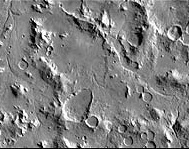 September 15:
September 15: ESA's Beagle 2 to touch down in Mars' Isidis Basin. "ESA sought to find a locale both scientifically interesting and safe to land. Unfortunately, the most intriguing sites — those identified this year as possible sources of liquid water springs — are located in dangerously steep or rocky terrain. The sandy dunes of Isidis... could soften the blow when the airbag-protected Beagle 2 bounces to a halt on Mars just over three years from now."
 Europeans pick landing site for Mars mission by Richard Stenger, CNN.com, 14 September 2000. Europeans pick landing site for Mars mission by Richard Stenger, CNN.com, 14 September 2000.
 Space Agency Chooses Landing Site On the Red Planet by Josh Chamot, Space.com, 12 September 2000. Space Agency Chooses Landing Site On the Red Planet by Josh Chamot, Space.com, 12 September 2000.
 Life on Mars! is a related CA webpage. Life on Mars! is a related CA webpage.
September 15: NASA forms planetary-protection committee to determine the care and handling of extraterrestrial samples. The internal group of about 15 people will be assisted by "another group with representatives from other federal agencies, including the departments of Health and Human Services; Agriculture; Interior; and Energy, as well as the Environmental Protection Agency (EPA) and the National Institutes of Health."
 Protecting the Earth by Paul Hoversten, Space.com, 11 September 2000. Protecting the Earth by Paul Hoversten, Space.com, 11 September 2000.

|


